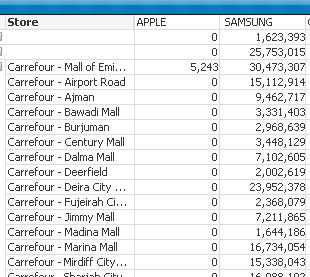Unlock a world of possibilities! Login now and discover the exclusive benefits awaiting you.
- Qlik Community
- :
- All Forums
- :
- QlikView App Dev
- :
- Re: Sort Expression in straight table...
- Subscribe to RSS Feed
- Mark Topic as New
- Mark Topic as Read
- Float this Topic for Current User
- Bookmark
- Subscribe
- Mute
- Printer Friendly Page
- Mark as New
- Bookmark
- Subscribe
- Mute
- Subscribe to RSS Feed
- Permalink
- Report Inappropriate Content
Sort Expression in straight table...
Hello Community,
i have a problem with sorting in straight table.. let me explain me..
i have a pivot table with two dimension and 3 expressions.
my expression are below:
1) SUM({<Brand = {"$(=trim(subfield(GetFieldSelections(Brand),',',1)))"}>} SellOut.Total_Sale)
2) SUM({<Brand = {"$(=trim(subfield(GetFieldSelections(Brand),',',2)))"}>} SellOut.Total_Sale)
3) column(1) -column (2)
user can select 2 Brand to see the difference , between two Brands. (i have more than 50 brands in list box)
let say if i select "SAMSUNG" AND "APPLE" in brand listbox. my chart look like below...(sample)

in the image above, store is my dimension, and APPLE is my first expression, and SAMSUNG is second Expression.
its sorted alphabetically....
but i want first column, which i select first, and second column which i select on no two..
let say if i select Samsung first, and then i select apple, then Samsung must be first column, and apple must be second...
but whatever i select it sort alphabetically all the time..
any idea....
Many Thanks
- « Previous Replies
-
- 1
- 2
- Next Replies »
- Mark as New
- Bookmark
- Subscribe
- Mute
- Subscribe to RSS Feed
- Permalink
- Report Inappropriate Content
this is what i have currently...
when you select samsung and apple in your brand list, then all the time apple comes as first column..even if you select sumsung first...
i want first column which i select first...
- Mark as New
- Bookmark
- Subscribe
- Mute
- Subscribe to RSS Feed
- Permalink
- Report Inappropriate Content
I'm very happy this can help you.
I try also to find a way to save in which order user select the values in a listbox but I dont find nothing, unfortunatelly.
Best regards.
- Mark as New
- Bookmark
- Subscribe
- Mute
- Subscribe to RSS Feed
- Permalink
- Report Inappropriate Content
yes, this is what i want...
but without alternate state.... 🙂
i have more than 100 brands, in your suggestions, i have to put two list boxes for same brands,
and user will chose two brands from two list boxes...
thanks for your time...really appreciate your effort..
many thanks
- Mark as New
- Bookmark
- Subscribe
- Mute
- Subscribe to RSS Feed
- Permalink
- Report Inappropriate Content
You are wellcome!
I'm very interesting if it is possible to store the users selection order in a Listbox.
Best regards.
- Mark as New
- Bookmark
- Subscribe
- Mute
- Subscribe to RSS Feed
- Permalink
- Report Inappropriate Content
surely we can help once u post ur application here...
- Mark as New
- Bookmark
- Subscribe
- Mute
- Subscribe to RSS Feed
- Permalink
- Report Inappropriate Content
This can be done by changes in the script. there you have to mention the way u want it..done the same thing in the past...
- Mark as New
- Bookmark
- Subscribe
- Mute
- Subscribe to RSS Feed
- Permalink
- Report Inappropriate Content
No, it's not sum all all possible brand-values - it takes only the first brand-value and it meant you need further to use two expressions - I have only one expression showed as example, therefore:
SUM({<Brand = {"$(=subfield(concat(distinct Brand, ',', BrandSorting),',',1))"}>} SellOut.Total_Sale)
SUM({<Brand = {"$(=subfield(concat(distinct Brand, ',', BrandSorting),',',2))"}>} SellOut.Total_Sale)
column(1) -column (2)
It's only the same like your example only that it used concat which offered as adavantage against getfieldselection a sorting option and which could be extend with additional condition maybe with an included set analysis.
And I fear it's the easiest and shortest solution. You could of course try to define the order with variables and actions but this is quite complex and it will fail if there is a multiple selection at one time (for example selection by pressing the ctrl-key). Further you could check which Brand has the most or max. value or similar and ordered them to these value.
Another very easy possibilty is to use two fields and listboxes (same values but different fieldnames) with the option to allow only one selected value and use listbox one for expression one and listbox two for expression two.
- Marcus
- « Previous Replies
-
- 1
- 2
- Next Replies »